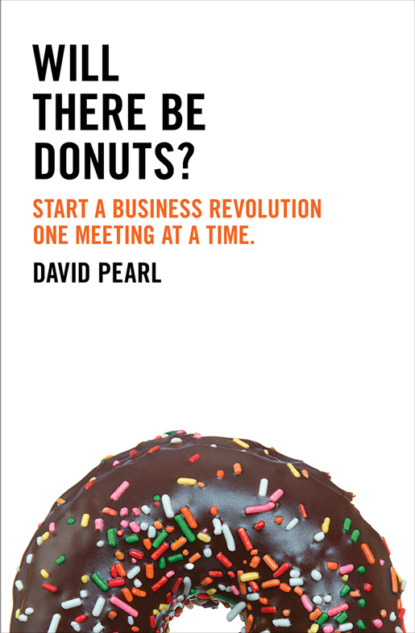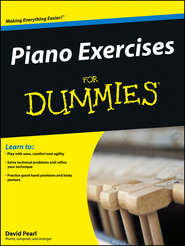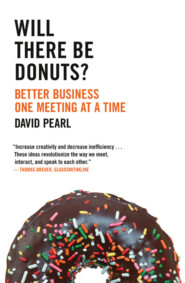По всем вопросам обращайтесь на: info@litportal.ru
(©) 2003-2024.
✖
Will there be Donuts?: Start a business revolution one meeting at a time
Автор
Год написания книги
2019
Настройки чтения
Размер шрифта
Высота строк
Поля
* (#ulink_7594f2d8-8e36-5dff-a635-2b3c29a49271) Despite our title I’m not sure I’d recommend a donut as a meeting snack. As the New York Obesity Research Center puts it, ‘The average donut is nothing more than refined sugar and flour, artificial flavors and partially hydrogenated oil that’s loaded with trans fats. When it comes to health, the only thing good about them is the hole.’
* (#ulink_08490026-da35-50cb-9bdc-70836276e592) Some clients do prefer the alternative Latin motto which goes: ‘Quaerimus Et Si Non Invenio Facimus Malum (we go looking for trouble – and if we don’t find any, we make some) but it’s harder to print on a T-shirt.
The Multi-billion pound ‘own goal’ of Business
I worked with a major UK insurance firm a few years ago. Every year eager executives would ask its CEO what his vision was for the following year. His answer was always the same: ‘To make one less huge mistake.’ He was experienced enough to know that the revenue would flow in. His concern was wasting it once it arrived. If he could tackle or prevent this year’s big – and avoidable – mistake, then the revenue would really count instead of gushing away into a deep hole of the company’s own making.
This chapter is about a big mistake that almost all companies are going to make this year. And the next. And the one after that. I call it Nearly Meeting.
How do you know if you are nearly meeting?
A nearly meeting is any meeting where the participants fail to get real value out of their coming together. They are the ones which offer a poor return on the time and effort invested – for the individuals taking part and the organisations they work for.
Nearly meetings are the ones where problems are half solved, the issues are partially understood, the right things are almost said. They come that close to being useful. If you ever stagger out of a meeting room wondering where the day went and what you did with it, you’ve probably been nearly meeting. You’ll have semi-resolved problems, almost discussed what truly needs to be discussed and practically decided what to do about it.
I am reminded of Billy Crystal’s magician character in William Goldman’s fairytale comedy The Princess Bride who claims the hero isn’t alive or dead, but ‘mostly dead’. And so it is with nearly meetings. We are ‘mostly’ meeting. And it’s completely frustrating.
People complain about the difficulties of virtual meetings – as though if only people were off the phone and in a room together the problem would be solved. All nearly meetings are virtual – whether you are face to face or not. We should probably not even call them meetings at all; missings would be more accurate.
‘Busy day, dear?’
‘Murder. I’ve been in back-to-back missings since 7.30.’
Nearly meeting is a strange no-man’s-land between being separate and really connecting. I suggest it’s where many of us spend the majority of our working days.
Counting the cost
Whoa. Did you just give me ‘the look’? It’s the imperceptible tightening of the brows and lips which says, ‘I am a hard-nosed business person and what does this soft issue have to do with my bottom line, sonny?’
I’ve seen it the length and breadth of the business world, from boardroom to shop floor. And when I see it I ask clients – as I ask you now – to consider the following:
Imagine you are in a role which requires you to attend three hours of meetings a day. And let’s say you’d score those meetings 70 per cent effective. Let’s also imagine there are 100 people like you in the company and that your average wage is, say, £60k. None of this is particularly far-fetched, you’d agree? OK, then.
You just wasted 82 days in meetings this year, costing your company a pretty significant £1m. What’s more, if you were to continue at this rate for a conventional career, you’d be burning a total of nine years, six months and three days of your working life.
This is hypothetical, but far from fantastical. Here’s a real example which I put in front of the board of a major pharmaceutical company who weren’t immediately convinced that ineffective meetings were having a significant effect on their business.
They’d called me in – as clients often do – to get more creativity into their working practices. People often feel this is a kind of spray-on process but quickly discover that the blocks to creativity lie in some very fundamental practicalities.
In the Pharma’s case the numbers were more like 4.5 hours spent in meetings per day, 60 per cent effectiveness, average fully loaded costs of 100,000 Euros and 2500 employees. Put them through the formula and there’s an eye-watering 56 million Euros of invaluable time and cost you just poured down the drain.
By any standards that’s a major mistake to be making. And to keep on making.
So yes, it’s a soft issue. But with a rock hard centre. It’s like flying through a cloud with a nasty, big mountain hidden inside it. The implications for your financial as well as physical wellbeing can be sudden and drastic.
When I am talking to people who like to differentiate their activities in terms of ‘hard stuff’ and ‘soft stuff’, I like to describe the work I do particularly with meetings as ‘the hard-soft stuff’. Soft, in that it’s broadly a people issue. And hard because it’s tough to fix.
When you start to really change meetings, you are tinkering with the culture of the business, and issues don’t come much trickier. It’s easy enough for your business to commit to culture change when you are on a blue-sky-thinking executive-retreat somewhere nice and warm. But visit the workplace a week or two later and you’ll find the ‘nearly meeting’ culture is as stuck as ever. We’ll look at how to change things more effectively a little later in the book.
Nearly Meetings are a worldwide epidemic. And epidemics are something that one of my clients Thomas Breuer knows more than most about. Thomas doesn’t have a golf trophy in his office. Nor one of those toe-curling posters shot against a Hawaiian sunset saying what a real leader is made of.
Thomas Breuer, a physician and epidemiologist by training, is Head of Global Vaccine Development (GVD) at GlaxoSmithKline Vaccines. In the GVD offices there are photographs of African women and their children. They are there to remind all of them of their deadline to license a malaria vaccine and the devastating prospect on mortality in Africa if they fall behind their target. And malaria is just one area of attention. When H1N1 swine flu last threatened the world, it was on Thomas’s watch. It explains why Thomas is intolerant of outdated processes and wasting time.
When Thomas took over his new role, his first act was to have multiple small informal lunches with groups across his entire staff of 1400 people.
What they told me again and again is that we are wasting huge time and money in meetings. The amount of money we were burning in people time in wasteful meetings was mind-blowing. I realised instead of hiring in or outsourcing there was one untapped jewel sitting in the middle of my department and that by doing meetings better I could create more time for people already in the company and who have the skills I need now.
So, how to engage a group of medics and scientists in meetings when they’d all rather be out saving the world from rotavirus, shingles, cancer and worse? The answer, it turned out, was to stop focusing on meeting efficiency and start thinking about meeting health. We set up a ‘meeting hospital’ and for three months we took in meetings that were sick, needy and near death and brought them back to life. Quite a few of the techniques in this book were developed in the casualty department of the meeting hospital.
The results read like one of those ‘before and after’ weight-loss posters on the tube. After three months 97 per cent of participants found meetings more purposeful, clear and engaging.
Clearly, with the right antidote and a big bucket of innovation we can tackle nearly meetings. But the question is, if they are so manifestly unhealthy, why do we keep having them?
We nearly meet because … in a mad world it makes sense
If I worked every day in some of the companies I visit, I am certain I would be nearly meeting in a week.
When I started working with one of my clients, part of their business had a monthly six-hour conference call involving 100 people around the world. That’s 72 hours a year or nearly two whole working weeks. Multiply that by the number of participants and you are looking at a collective year and a half of working life. It had better be a pretty important subject, wouldn’t you think? But it wasn’t. It was a business-as-usual thing. No one wants to be in that meeting. Certainly not for six hours. But no-one feels that they can legitimately not take part. So they sit there, rolling their eyes in various locations around the world, one eye on the blackberry, the other on the clock, pretending to meet. In an illogical system, it’s the logical response.
We dealt with this meeting in a way that I strongly recommend you try in your own company. We blew it up. And then we only put back what was absolutely needed. It turned out that the real hot topics could be best showcased in a bimonthly webforum. And the informal information sharing is now done, café style, at the end of the day every six weeks or so.
We nearly meet because … we have lost control of our diaries
I have come to realise that diaries are like houses. It is easy to fill them both with unwanted clutter.
In 2008 the Pearls decided to spend a couple of years living in Italy. When we rented out our house in London we put half the furniture in storage and took the rest with us to Piedmont. On our return we had only 50 per cent of our original furniture and the house felt – absolutely fine! Or to put it another way, we had been living with twice as much stuff as we needed but hadn’t noticed because we had got so used to all the clutter around us, we’d stopped seeing it. So, now take a look at your diary and all the meetings in it. Which half needs to go into storage? There will be two kinds of meetings cluttering up your day: Standing meetings and Ad Hoc ones.
Standing meetings are the regular ones which are fixed (daily, weekly, monthly, quarterly) at the beginning of the year and/or project. They are like the furniture, fixtures and fittings. You don’t necessarily know who gave them to you or why they are there, but they have been around so long you have ceased to notice them; they have become the background to your life. The rest are Ad Hoc meetings. They appear unexpectedly in response to a situation, problem or request. I think of these as impulse buys that you see at the weekend and ‘must have’, or mail – including junk mail – that arrives on your doormat clamouring for your attention.
The rules for de-cluttering a house or diary are very similar. You need a brutal cull of the unwanted contents you have accumulated and a severely selective, No Junk, entry policy to prevent any new rubbish crossing the threshold.
We nearly meet because … it’s an attractive alternative to real work
Steve, a prominent LA tax and business advisor, takes client service seriously. And so he should. His starry clients are the sort of people who expect him to be on call 24/7.
In case you were thinking your senior people are capriciously demanding, you should spend a day or two in the performing arts where Stars can be really Starry. One tale I know to be true from my time in the opera world is that of a sumptuously gifted but notoriously high-maintenance operatic soprano who was feeling a little warm in the back of her limo while driving through Manhattan. Too grand to lean forward and ask the driver to turn up the air-conditioning, she picked up the limo phone, called her agent in Los Angeles, who then called the driver in New York with the message.
Steve talks of his earlier career in a large corporate practice where he was expected to attend a daily meeting at 11.00 known (I kid you not) as the Donut Meeting because there was nothing much else to talk about. ‘I was an outlier,’ he admits.
I was one of the few people who thought that if you are in a service company that the real priority was to, well, serve clients. I felt that instead of sitting around shooting the breeze there might be things that the client would actually want you to do, things you were, er, paid to do. So I used to excuse myself from the Donut meetings and go to talk to some clients. Actually pick up the phone and speak to them. It seemed to me that most of the others were actually scared of doing that. You’d ask them if they had called client A and they’d answer yes. ‘When?’ Three weeks ago. ‘And since then?’ Well, they’d been busy in meetings.
Clients don’t want to hear you are in meetings. They want to hear you on the other end of the phone. It’s not great telling billionaire clients bad news, but I find it’s always better than hiding away. Instead of holding a Donut meeting, I would go and talk to a few people and get the job done.
Steve has nicely summed up one of the key messages of this book. Instead of holding wasteful meetings, get out there and start having the real meetings and conversations that really matter.
Or, as the T-shirt would say: Less Meetings – More Meeting.
We nearly meet because … technology







